🎹 UPDATED REVIEW – Dec 1, 2023 – The Yamaha YDP-184 is the top model in the Yamaha Arius series digital pianos and borrows some of its digital features from the Yamaha Clavinova digital pianos. The YDP-184 is a good digital piano (with the exception of the key action being heavy) for its $2399 price, although the newer Yamaha CLP-735 at $2899 would be a much better long term piano investment in my opinion, especially if you want to progress in your piano playing skills. With good looks, nice tone, and a fairly intuitive user interface, the Yamaha YDP-184 still is worth consideration for a new digital piano between $2000 to $2500.
The Yamaha YDP-184 ($2399 internet discount price) is a good model because it incorporates some of the features, the user interface, and some of the instrument sounds from the popular higher priced Clavinova CLP-735 digital piano ($2899 internet discount price) and put them into the YDP-184. So when comparing these two models, the YDP-184 has a similar cabinet design as the CLP-735, but the YDP-184 is only available in the matte rosewood color whereas the CLP-735 is available in a number of cabinet finishes. The YDP-184 has the highest price for an Arius series model that Yamaha has ever had because usually the internet discount price of an Arius series piano is below $2000 selling price. So to see the YDP-184 selling at discount for $2399 is a new price level bringing it up over that $2000 price range. So is the YDP-184 worth its selling price? You can find out below.
To begin with, many people ask me what the real difference is between the top Arius model YDP-184 and the 2nd Clavinova model up Clavinova model CLP-735 because they are only $500 apart. Once you are at $2400 it’s really not that much of a stretch for many people to go up to $2899. The new Yamaha Clavinova CLP-735 for $2899 has a new and noticeably upgraded key action and piano sound chip and stereo grand piano sound engine over the YDP-184 whereby it combines improved piano sampling technology with some physical modeling piano sound technology allowing for a more natural, more dynamic, and more impressive acoustic piano sound. The key action in the new CLP-735 is lighter and the keys move up & down more naturally as compared to the YDP-184 which has a noticeably heavier key movement.
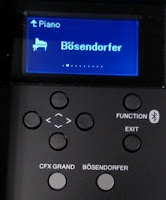 |
| Yamaha CLP735 panel |
Speaking of piano sound technology, to really get a dynamically responsive and rich piano sound, the digital piano would need to recreate the nuanced organic tones that come from the wood body of a real acoustic piano along with string vibrations, sympathetic resonances and tonal overtones plus being able to sample the original grand piano in such a way that the final result of that piano sound would not be artificial in tone, but instead would be more natural and organic. In the YDP184 and all the new Yamaha Clavinova pianos, Yamaha has accomplished this task by combining sampling technology with physical modeling technology (creating piano sounds in a computer using mathematical algorithms) in a way that allows for a fuller, more expressive piano sound whether you are playing staccato, legato, using lots of damper/sustain, playing single notes, multiple notes and chords at one time, or however you want to play.
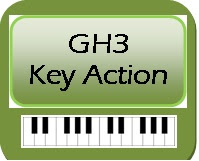

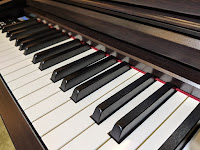
But there are other feature differences between the two models besides the piano sound technology. One of those things is the key action and how it works. Basically the key actions in the Arius models including the YDP-164 and now the YDP-184 all have the same key action “feel & weight” and they call that key action GH3. However, the key action on the Clavinova 700 series has the new Grand Touch-S key action with escapement. This feature is noticeable when pressing down a key whereas the Arius series does not feel nearly as balance with its key action as compared to the new CLP-735. Also, the escapement feature in the key action is supposed to help reproduce the movement feel of a grand piano vs an upright piano when the keys are being pressed down, as I mentioned earlier.
Pedaling response is important on pianos and the YDP-184 is no exception. All three pedals work nicely including damper/sustain, sostenuto, and soft pedal. The most important pedal by far is the right damper pedal which allows sustain to occur on the notes you are playing so the sound holds on longer and helps create a beautiful tone, especially when playing slower legato musical passages. Sustain ties together one note to the next and the better the piano sound of the sustained note the more expressive and full bodied your music will become. The sustained piano tones on the new YDP-184 is a big advancement from previous models and far exceeds any of the other Arius models at this point. There are longer piano sustain-decay times coupled with good half-damper response allowing variations of sustain length of time that you hear with the piano sound before it fades out while holding the pedal down.
OK…now it’s time to talk about some of the cool things this model has inside of it. The first thing are all the instrument sounds with a total of 24 voices (aka: instrument sounds) which include 4 acoustic piano sounds including the main stereo Yamaha CFX Grand and 3 others along with the rest of the sounds which are non-acoustic piano sounds including harpsichord, stereo symphony strings, electric pianos, choirs, organs, guitar, etc. In the Clavinova series digital pianos there are a total of 36 instrument sounds with 10 of them being acoustic pianos. So the big difference in sounds between the YDP-184 and the Clavinova CLP735 is that the CLP735 has 6 more acoustic pianos sounds than the YDP-184 (along with 2 vintage acoustic piano tones) and those extra piano sounds include the Bosendorfer 9′ Viennese Grand Piano which as I mentioned earlier, is a very beautiful piano tone. So there are more acoustic piano selections in the CLP-735 although the 4 piano tones in the YDP-184 are still very good and for many people may be more than enough. The other instrument sounds I mentioned are good but some are not spectacular in terms of authenticity. But that’s OK, not everyone cares about the other instrument sounds as much, particularly ones that you would use as often:).
The control panel in the YDP-184 is quite useful and works well. It is intuitive to use overall and located just to the right of the keyboard which gives the piano a more minimalist appearance as opposed to many buttons all over the piano. There are direct access buttons and controls that take you right to the function or feature and there are other features that take a few more button pushed or steps to activate, but overall this functional control panel is much better than in previous models and is pretty much the same as the control panels in the current Clavinova series. This is the first time that Yamaha has included this upgraded user interface with its larger LCD screen in one of their Arius series pianos. Until now this control panel was only found in the higher priced Clavinova series.
With regard to the direct access buttons on the control panel to the left side of the keyboard, Yamaha includes separate buttons for the Yamaha CFX grand piano sound, the strings violins, the voice button which brings up all the instrument sound categories and tones, the dual/split button which allows instant layering of two sounds or being able to assign one sound for the left hand and a different sound for the hand, the “piano room” button which gives you direct access to some of the editing effects which can be applied to the piano sound like reverb, lid position, brilliance, etc so that you can customize the piano sounds if you want to.
Some of the other features of the YDP-184 include being able to have two students play the same song in the same octaves at the same time on the piano. This is called the “duo” function and is great for two people in the same family who are working on the same song at the same time and playing together which might be helpful and save time. This Duo feature is not to be confused with the “layer” feature which allows for combining 2 different sounds at the same time when you play the piano such as having piano & strings, organ & harpsichord, etc. Another way to use this Duo feature is for a teacher who is coming to your home to teach the student is for playing the same song together and the teacher wants to play along with the student at the same time playing the same notes…this is called “Duo” and the piano is digitally split into two 44-note portions which each portion sounding identical and in the same octaves. It’s a cool thing to have but not one that is really practical unless you need it for the situations I mentioned.
Another cool feature that the YDP-184 offers is the ability to record 16 separate tracks or instruments as a complete song. You can create and arrange a song and then record one instrument sound at a time up to 16 different sounds and then they all play back simultaneously as one complete song just like a recording studio. It lots of fun and can be great in learning to improvise, record in the multi-track platform, and be able to arrange music like the professionals can do. The YDP184 cannot record and playback General MIDI song files that are prominent on the internet and in other MIDI multi-track recording which a few other digital pianos in this price range are able to do. However, for the price, the recording features are pretty cool.
As far as internal speaker system and connectivity in this model, there are two larger speakers going into 60 watts of total stereo audio power which gives the YDP184 plenty of volume for most homes, small churches, or small venues. Having only two speakers is generally fine but a 4-speaker system would have been better adding smaller tweeters to project high frequency in a more dynamic way, but this would also be true for the Clavinova CLP-735 having a similar internal speaker system (but a bit better) as in the YDP-184. With regard to connectivity in the YDP-184, it offers standard MIDI input & output along with USB output to external device USB flash drive input for song storage from your recordings or playing music you have downloaded from the internet, audio
output jacks for connection to external sound systems, stereo audio input to enable your external music devices (iPad, mobile phone, etc) to run their sound through the Yamaha internal speaker system which is a very useful thing to have, and lastly there are 2 stereo headphone jacks for private playing so that other people cannot hear what you are doing…always great when there are other people nearby who don’t want to hear you play or practice, or maybe want to sleep you you feel like playing late at night:).
The Yamaha YDP-184 cabinet is only offered in the matte dark rosewood finish which I mentioned earlier and the measurements are 58″x 37″x 18″(18″ depth from wall) and it weighs in at approx 123 lbs. The YDP184 comes with a comfortable matching padded bench, built-in sliding key cover, nice supportive music rack where the sheet music would go, and the rosewood color does have some noticeable simulated grain in the finish so it does look nice. Also the piano cabinet does have a full privacy panel that covers the back of the piano so you can’t see through it and that is something most people like to have on their piano. I did want to mention the the higher priced Yamaha Clavinova CLP735 music rack has some music braces on the music rack so the sheet music cannot easily slip off the music holder and pages in a book can be made to stay open. Sometimes it’s the little things that can make a big difference and the music braces is one of those little things that adds value to any digital piano in my opinion.
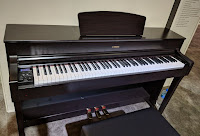
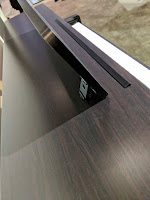
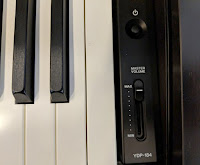
So the bottom line is this: The Yamaha YDP-184 is a fine piano for beginners thru advanced players in that it offers a very good piano playing experience for most people who want to be in its price range of $2399 internet discount price. It has enough “bells & whistles” and practical digital features as I have previously explained to satisfy a variety of playing skill levels along with a more realistic piano tone than ever before in a Yamaha Arius. But make no mistake about it…this piano is not a grand piano by any stretch of the imagination, and although its one main piano sound is sampled (recorded) from a real Yamaha grand piano, that does not make this YDP-184 a grand piano because the key action in a real Yamaha grand is built and functions in a far different way than the all-plastic GH3 key action in this digital model. It is interesting to note that in Yamaha’s on-line promotional description of the YDP-184 on their main web site, Yamaha says the following:
piano-style response and feel. The words they use to describe this new model as having a “grand piano-style response and feel” is, in my opinion, stretching the truth in a big way, but I am not surprised by statements like this because manufacturers in general seem to want people to believe that every digital piano out there can behave and play just like a real grand piano, which most of them don’t. Oh well…just don’t believe everything you read from the digital piano manufacturers because after all, they are trying to get you to buy their products…right?
By the way, an excellent alternative to the YDP-184 that I like very much is a very nice model from the Kawai piano company called the CN201. It’s slightly less money at $2299 and in my opinion after having played it quite a few times, this new model provides a noticeably more realistic key action movement and piano playing experience along with being in a well designed furniture cabinet that has traditional looks coupled with advanced piano sound technology which replicates the piano playing experience in a way that other home digital pianos cannot do in this price range. Go to the following link to read my detailed review of the Kawai CN201: Kawai CN201 Review
If you want more info on new digital pianos and LOWER PRICES than internet discounts, please email me at tim@azpianowholesale.com or call direct at 602-571-1864.
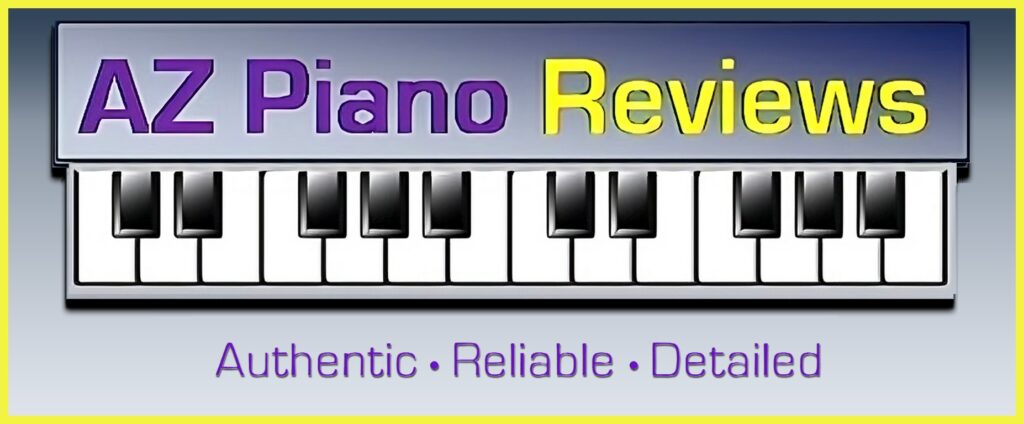


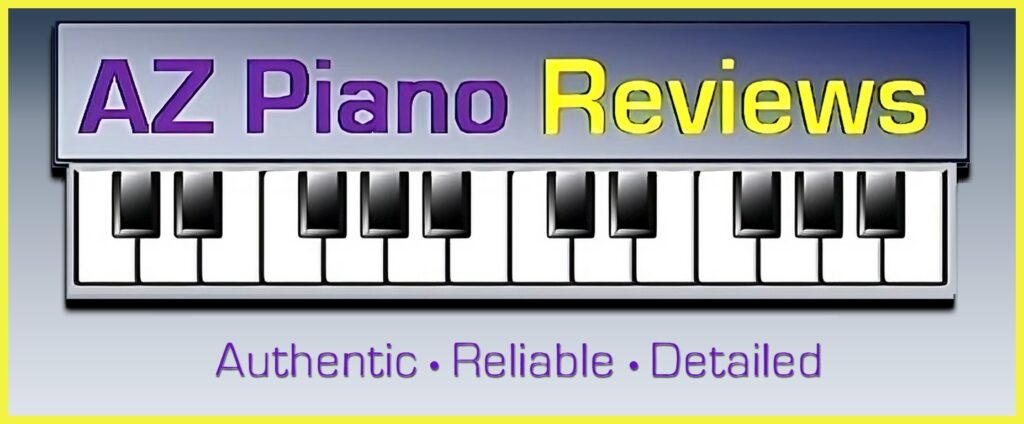
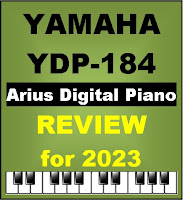


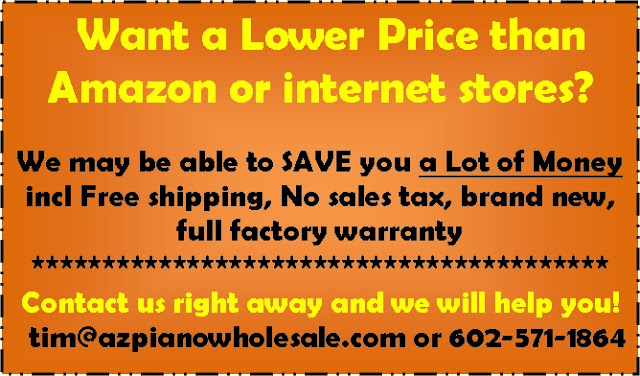

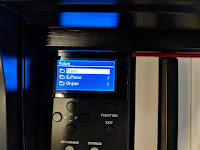
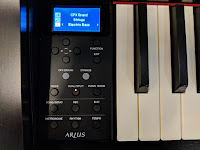
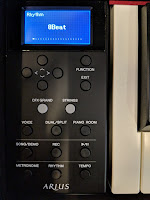
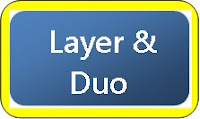
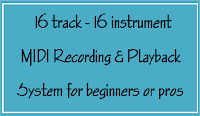
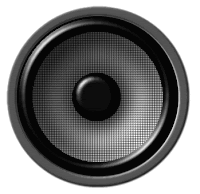
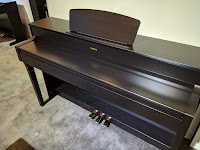
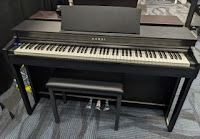




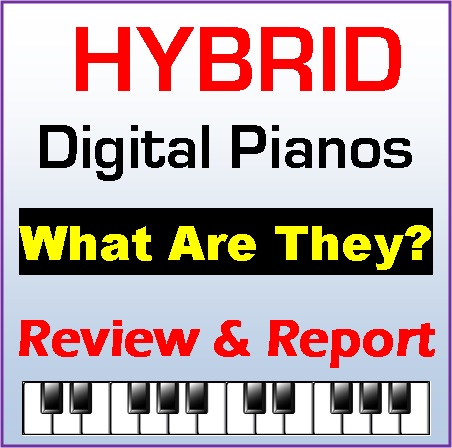





Tim, thanks for your review of the YP 184. I own one and have adjusted to the heavier action without too much trouble. Did I miss any word on the Yamaha Smart Pianist accessory that only a few other brands have something similar and seems to be a feature worth while. The navigation in some digital pianos is a nightmare to learn but this Pianist makes it much easier. What say You?
I prayed for your grandson today. I have a milder form of leukemia.
Pastor Ron Thompson